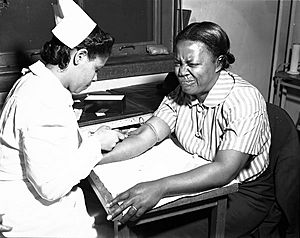Injection facts for kids
An injection (often called a "shot") is a way to put liquid medicine or other substances into your body. This is usually done using a needle and a syringe. Injections are a common medical procedure that helps keep people healthy or treat illnesses.
Contents
Why Do We Get Injections?
People get injections for two main reasons: to prevent illnesses or to give medicine.
Preventing Illnesses: Vaccines
Many injections are given to prevent you from getting sick. These are called vaccines (or immunizations). Vaccines work by putting a tiny, safe amount of a virus or bacteria into your body. This might be a dead or weakened version of the germ. Your body then learns to recognize this germ. If you encounter the real germ later, your body will "remember" it and be ready to fight it off quickly, often before you even feel sick. This helps protect you and others around you from serious diseases.
Giving Medicine
Injections are also used to deliver medicine directly into your body. This is often done when medicine needs to work quickly, or when it can't be taken by mouth (like a pill). For example, some medicines for pain, allergies, or infections are given by injection.
Different Kinds of Injections
Injections can be given in different ways, depending on what the medicine is for and how quickly it needs to work. Here are some common types:
- Intradermal: This type of injection goes just under the very top layer of your skin. It's often used for certain tests, like allergy tests.
- Subcutaneous: This injection goes into the fat layer right under your skin. It's a common way to give medicines like insulin for diabetes.
- Intramuscular: This means the injection goes deep into a muscle. Many vaccines are given this way because muscles have a good blood supply, which helps the medicine spread.
- Intravenous: Often called an "IV," this injection goes directly into a vein. Medicines given intravenously work very quickly because they go straight into your bloodstream.
- Intraosseous: This is a less common type, where the injection goes into a bone. It's usually used in emergencies when other ways to give medicine are not possible.
- Intraperitoneal: This injection goes into the abdominal cavity, which is the space inside your belly that holds many organs.
See also
 In Spanish: Inyección para niños
In Spanish: Inyección para niños


